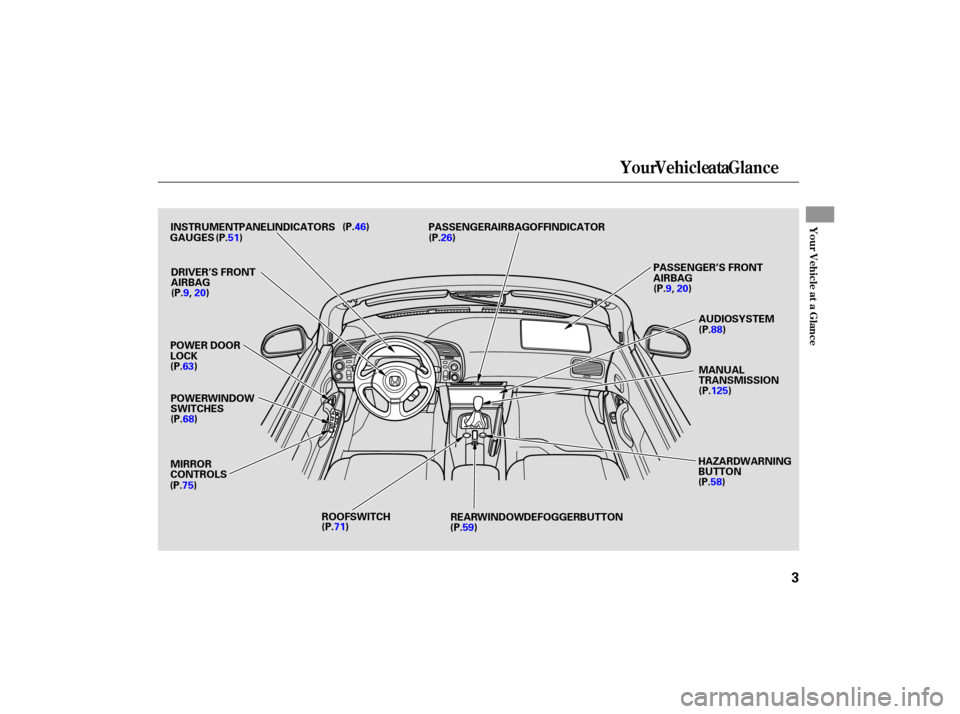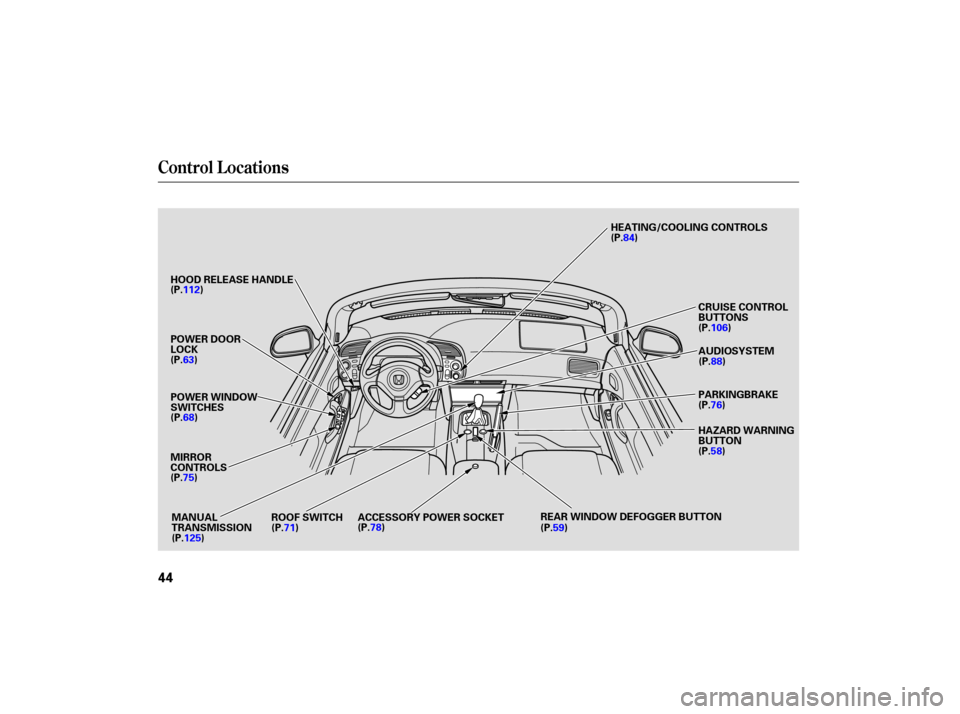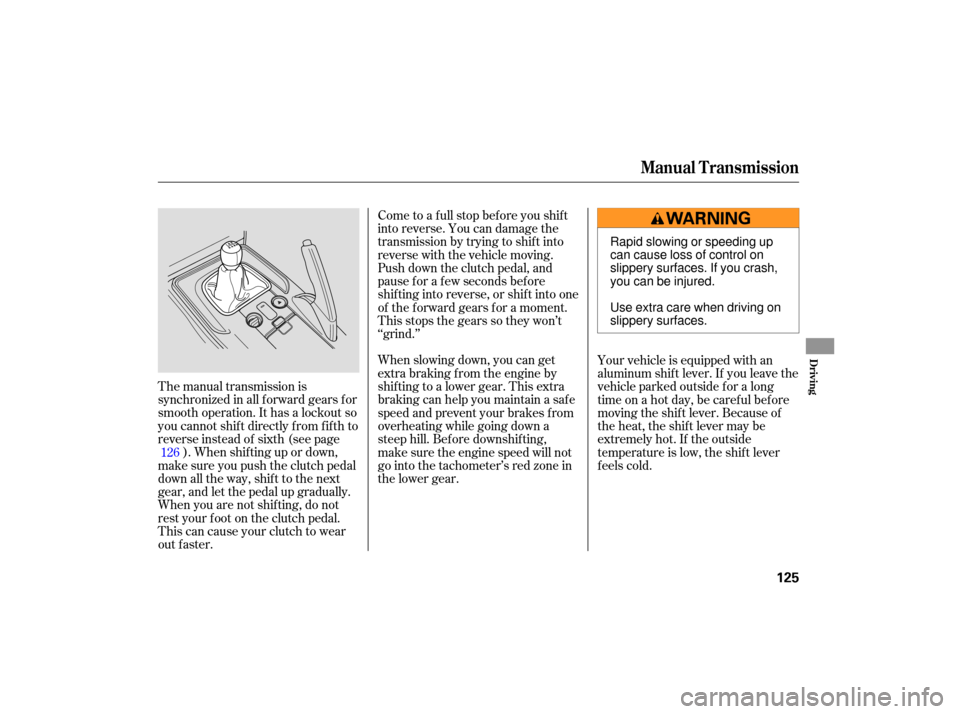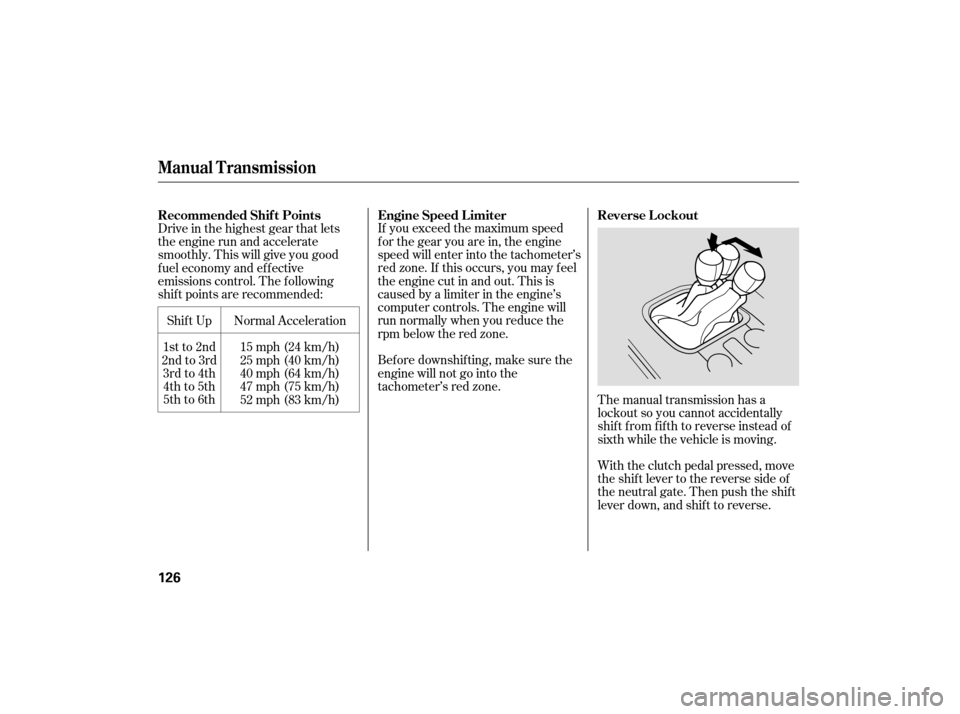2007 HONDA S2000 manual transmission
[x] Cancel search: manual transmissionPage 1 of 228

2007 Honda S2000 Online Reference Owner's Manual
Use these links (and links throughout this manual) to navigate through\
this reference.
For a printed owner's manual, click on authorized manuals or go to www.h\
elminc.com.
Contents
Owner's Identification Form
Introduction ........................................................................\
.................................................................i
A Few Words About Safe ty
........................................................................\
........................................iii
Your Vehicle at a Glance........................................................................\
.............................................3
Driver and Passenger Safety ........................................................................\
......................................5
Proper use and care of your vehicle's seat belts, and Supplemental Restr\
aint System.
Instruments and Control s........................................................................\
.........................................43
Instrume nt panel indicator and gauge, and how to use dashboard and steering colu\
mn controls.
Comfort and Convenience Features ........................................................................\
...................... 83
How to operate the climate control system, the audio system, and other c\
onvenience features.
Before Driving........................................................................\
..........................................................109
What gasoline to use, how to break -in your new vehicle, and how to load luggage and other cargo.
Driving ........................................................................\
......................................................................121
The proper way to start the engine, shift the transmission, and park, pl\
us towing a trailer.
Maintenance........................................................................\
.............................................................133
The Maintenance Schedule shows you when you need to take you r vehicle to the dealer.
Taking Care of the Unexpecte d........................................................................\
..............................173
This section covers several problems motorists sometimes experience, an d how to handle them.
Technical Informatio n........................................................................\
.............................................199
ID numbers, dimensions, capacities, and technical information.
Warranty and Customer Relations (U.S. and Canad a)................................................................211
A summary of the warranties covering your new Acura, and how to contact \
us.
Authorized Manu als (U.S. only)........................................................................\
..............................215
How to order manuals and other technical literature.
Index........................................................................\
.............................................................................. I
Service Information Summary
A summary of information you need when you pull up to the fuel pump.
Accord Value Package Audio System
Page 6 of 228

Your Vehicle at a Glance
You r Vehicle at a Glance
3
POWER WINDOW
SWITCHES
MIRROR
CONTROLS
ROOF SWITCH AUDIO SYSTEM
INSTRUMENT PANEL INDICATORS
GAUGES PASSENGER AIRBAG OFF INDICATOR
MANUAL
TRANSMISSION
REAR WINDOW DEFOGGER BUTTON HAZARD WARNING
BUTTON
(P.46)
(P.51)
(P.63) (P.68)
(P.75) (P.71) (P.59) (P.58)
POWER
DOOR
LOCK (P.26)
DRIVER’S FRONT
AIRBAG PASSENGER’S
FRONT
AIRBAG
(P.9, 20) (P.9,
20)
(P.88)
(P.125)
Page 47 of 228

Control Locations
44
POWER WINDOW
SWITCHES
MIRROR
CONTROLS
ROOF SWITCH ACCESSORY POWER SOCKET REAR
WINDOW DEFOGGER BUTTONHAZARD
WARNING
BUTTON
(P.68)
(P.75) (P.71) (P.78)
(P.59)(P.58)
POWER
DOOR
LOCK
(P.63) AUDIO SYSTEM
PARKING BRAKE
MANUAL
TRANSMISSION CRUISE
CONTROL
BUTTONS
HOOD
RELEASE HANDLE HEATING/COOLING
CONTROLS
(P.112)
(P.125) (P.76)
(P.88)
(P.106)
(P.84)
Page 124 of 228

This section gives you tips on
starting the engine under various
conditions, and how to operate the
manual transmission. It also includes
important inf ormation on parking
your vehicle and the braking system.........................
Driving Guidelines .122
........................
Preparing to Drive .123
.......................
Starting the Engine .124
...................
Manual Transmission . 125
...........................................
Parking .127
.............................
Braking System .127
...............
Anti-lock Brakes (ABS) . 128
Vehicle Stability Assist (VSA) ........................................
System .130
...........................
Towing a Trailer .131
Driving
Driving
121
Page 128 of 228

The manual transmission is
synchronized in all forward gears for
smooth operation. It has a lockout so
you cannot shift directly from fifth to
reverse instead of sixth (see page
). When shif ting up or down,
make sure you push the clutch pedal
down all the way, shift to the next
gear, and let the pedal up gradually.
When you are not shif ting, do not
rest your f oot on the clutch pedal.
This can cause your clutch to wear
out f aster. When slowing down, you can get
extra braking f rom the engine by
shifting to a lower gear. This extra
braking can help you maintain a safe
speed and prevent your brakes f rom
overheating while going down a
steep hill. Bef ore downshif ting,
make sure the engine speed will not
go into the tachometer’s red zone in
the lower gear.
Your vehicle is equipped with an
aluminum shif t lever. If you leave the
vehicle parked outside f or a long
time on a hot day, be caref ul bef ore
moving the shift lever. Because of
the heat, the shift lever may be
extremely hot. If the outside
temperature is low, the shif t lever
f eels cold.
Come to a full stop before you shift
into reverse. You can damage the
transmission by trying to shift into
reverse with the vehicle moving.
Push down the clutch pedal, and
pause f or a f ew seconds bef ore
shif ting into reverse, or shif t into one
of the f orward gears f or a moment.
This stops the gears so they won’t
‘‘grind.’’
126
Manual T ransmission
Driving
125
Rapid slowing or speeding up
can cause loss of control on
slippery surfaces. If you crash,
you can be injured.
Use extra care when driving on
slippery surfaces.
Page 129 of 228

If you exceed the maximum speed
f or the gear you are in, the engine
speed will enter into the tachometer’s
red zone. If this occurs, you may f eel
the engine cut in and out. This is
caused by a limiter in the engine’s
computer controls. The engine will
run normally when you reduce the
rpm below the red zone.
Bef ore downshif ting, make sure the
engine will not go into the
tachometer’s red zone.With the clutch pedal pressed, move
theshiftlevertothereversesideof
the neutral gate. Then push the shift
lever down, and shift to reverse.
Shif t Up
1st to 2nd
2nd to 3rd 3rd to 4th4th to 5th
5th to 6th Normal Acceleration
15 mph (24 km/h)
25 mph (40 km/h)
40 mph (64 km/h)
47 mph (75 km/h)
52 mph (83 km/h)
Drive in the highest gear that lets
the engine run and accelerate
smoothly. This will give you good
f uel economy and ef f ective
emissions control. The f ollowing
shif t points are recommended:
The manual transmission has a
lockout so you cannot accidentally
shif t f rom f if th to reverse instead of
sixth while the vehicle is moving.
Recommended Shif t Points Engine Speed L imiter
Reverse L ockout
Manual T ransmission
126
Page 136 of 228

This section explains why it is
important to keep your vehicle well
maintained and how to follow basic
maintenance safety precautions.
If you have the skills and tools to
perform more complex maintenance
tasks on your vehicle, you may want
to purchase the service manual. See
page f or inf ormation on how to
obtain a copy, or see your dealer. This section also includes
instructions on how to read the
maintenance minder messages on
the information display, a
maintenance record, and instructions
for simple maintenance tasks you
may want to take care of yourself. ......................
Maintenance Saf ety .134
....................
Maintenance Minder . 135
....................
Maintenance Record .143
..............................
Fluid Locations .145
........................
Adding Engine Oil .146
.........
Changing the Oil and Filter . 147
..............................
Engine Coolant .149
....................
Windshield Washers .151
........
Manual Transmission Fluid . 152
..........................
Dif f erential Fluid .153
................
Brake and Clutch Fluid . 154
.............................................
Lights .155
................
Cleaning the Seat Belts . 160
.....................................
Floor Mats .161
..................
DustandPollenFilter . 161
..............................
Audio Antenna .161
.................................
Wiper Blades .162
...........................................
Wheels .163
...............................................
Tires .163
...................
Checking the Battery . 169
.............................
Vehicle Storage .171
215
Maintenance
Maint enance
133
Page 155 of 228

Check the f luid level with the
transmission at normal operating
temperature and the vehicle sitting
on level ground. Remove the
transmission f iller bolt, and caref ully
f eel inside the bolt hole with your
f inger. The f luid level should be up
to the edge of the bolt hole. If it is
not, add Honda Manual
Transmission Fluid (MTF) until it
starts to run out of the hole. Install
the f iller bolt, and tighten it securely.If you are not sure how to check and
add f luid, contact your dealer. The transmission should be drained
and ref illed with new f luid according
to the intervals shown on the
inf ormation display. If Honda MTF is not available, you
may use an SAE 10W-30 or 10W-40
viscosity motor oil with the API
Certif ication seal that says ‘‘FOR
GASOLINE ENGINES’’ as a
temporary replacement. However,
motor oil does not contain the proper
additives, and continued use can
cause stiffer shifting. Replace as
soon as it is convenient. Put a new washer on the f iller bolt,
then reinstall the f iller bolt and
tighten it securely.
Manual T ransmission Fluid
152
CORRECT LEVEL
FILLER BOLT